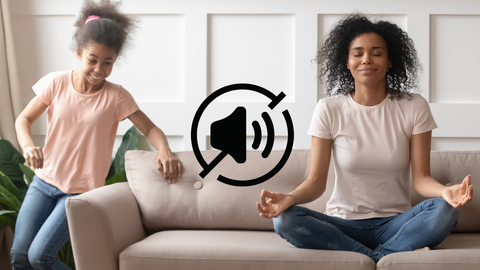
Calming Music vs. White Noise

The world is full of noise, and it can be challenging to find a moment of peace and tranquillity.
Many people turn to calming music or white noise to help them relax, sleep better, or concentrate on their work.
In this article, we'll explore the differences and similarities between calming music and white noise, their various benefits, and how to choose the right option for your needs.
What is Calming Music?
Calming music refers to soothing, gentle, and often slow-tempo music that helps create a peaceful atmosphere. It's designed to induce relaxation, reduce stress, and improve mood.
Types of Calming Music
There are various types of calming music, including:
- Ambient music: Characterised by atmospheric soundscapes and minimal instrumentation.
- Classical music: Some classical compositions, like Mozart or Bach, are known to have a calming effect.
- Nature sounds: Featuring recordings of rain, ocean waves, or birdsong, these sounds can be soothing and calming.
- World music: Traditional music from different cultures, such as Indian ragas or Tibetan singing bowls, can promote relaxation.
Benefits of Calming Music
Listening to calming music offers several benefits:
- Reduces stress and anxiety: Studies have shown that calming music can lower cortisol levels, the body's primary stress hormone.
- Enhances sleep: Calming music can help people fall asleep faster and improve the overall quality of their sleep.
- Increases focus: Soothing music can help people concentrate better by creating a distraction-free environment.
- Boosts mood: Calming music can elevate mood by stimulating the release of feel-good chemicals like serotonin and dopamine.
What is White Noise?
White noise is a type of noise that consists of equal amounts of all frequencies audible to humans. It's similar to the sound of a TV or radio tuned to an unused channel.
Types of White Noise
There are different types of white noise, including:
- Brown noise: Lower frequencies dominate, resulting in a deep, rumbling sound.
- Pink noise: More balanced than white noise, with equal energy per octave, often compared to the sound of rain.
- Blue noise: Higher frequencies dominate, creating a hissing sound.
Benefits of White Noise
White noise offers several benefits:
- Improves sleep: Studies have shown that white noise can help people fall asleep faster and maintain sleep throughout the night.
- Reduces distractions: White noise can help block out sudden noises that can be disruptive, making it easier to focus on tasks.
- Relieves tinnitus: White noise can help mask the symptoms of tinnitus, providing relief for those who suffer from it.
- Calms babies: White noise mimics the sounds babies hear in the womb, helping them feel more secure and sleep better.
Calming Music vs. White Noise: Similarities and Differences
While both calming music and white noise offer relaxation and sleep benefits, they have some differences and unique advantages. Let's explore these similarities and differences in various aspects of daily life.
Sleep Improvement
Both calming music and white noise can improve sleep quality. However, personal preferences play a significant role in choosing which option is more effective.
Some people may find calming music more soothing and conducive to sleep, while others may prefer the consistent sound of white noise to block out distractions.
Stress Reduction
Calming music has a more direct effect on stress reduction due to its ability to lower cortisol levels and evoke positive emotions.
White noise can also contribute to stress relief by providing a distraction-free environment, but its impact is less direct compared to calming music.
Concentration and Focus
When it comes to focus and concentration, white noise might be more beneficial for some individuals.
By blocking out sudden noises, white noise creates a consistent background sound that allows for better concentration. However, some people may find calming music more effective for maintaining focus, depending on their personal preferences.
Tinnitus Relief
White noise has a clear advantage in providing relief for tinnitus sufferers by masking the ringing or buzzing sounds associated with the condition.
Calming music can still offer some respite, but white noise is generally more effective in this regard.
Personal Preferences
Ultimately, the choice between calming music and white noise comes down to personal preference.
Some people may enjoy the emotional and melodic aspects of calming music, while others may prefer the neutrality and consistency of white noise.
In Summary
Both calming music and white noise offer various benefits for relaxation, sleep, focus, and stress reduction.
While they share some similarities, their differences lie in the listening experience, emotional impact, and personal preferences.
To determine which option is best for you, consider your unique needs and preferences, and don't be afraid to experiment with both to find the perfect balance.
FAQs
Can I use both calming music and white noise together?
Yes, you can combine calming music with white noise to create a unique soundscape tailored to your preferences.
Is there a specific type of calming music that works best for relaxation?
It largely depends on personal preferences. Different types of calming music can be effective for different individuals. Experiment with various genres to find what works best for you.
Are there any side effects of using white noise for extended periods?
While white noise is generally safe, it's essential to keep the volume at a comfortable level to avoid potential hearing damage.
Can I use calming music or white noise for meditation?
Yes, both calming music and white noise can be used to enhance your meditation practice by providing a peaceful and focused environment.
How loud should I set the volume for calming music or white noise?
Set the volume at a comfortable level that effectively blocks out distractions without being too loud or overwhelming.
